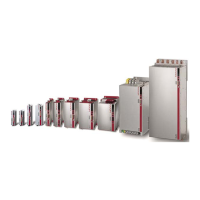If the I
2
t method is set to "THERM(1) = Thermal time constant-dependent", all settings
apart from the thermal thermal time constant are disabled.
If the integrator exceeds its limit value, the error E-09-01 is triggered. The current
value of the integrator is indicated in P701[0] - Mon_ActValues.
NOTE
Thelimitsarespecifiedinservodriveaspercentagesoftherated
quantities(e.g.current,torque,speed,...)ofthemotor.Thedefaults
relateto100%oftheratedquantities.
Calculation of capacity utilization via exponential function with thermal
time constant of motor:
Setting of I
2
t type:
P 735[0]=“FREQ(0)=Outputfrequency-dependent":Moog-specifici(f)
evaluation
P 735[0]=“THERM(1)=Thermaltimeconstant-dependent":Evaluationbased
onthermaltimeconstanti(Tth)
ThermaltimeconstantP 733[7] - Tthermin[s]
Theshut-offthresholdis110%(reductionincurrentnoise)
MOOG
ID
No.: CB40859-001 Date: 02/2018
MSD Servo Drive- Device Help
42
5 Motor
5.5.3AsynchronousmotorI²tmonitoring
The following diagram shows a typical characteristic setting for an internally cooled
asynchronous motor. For third-party motors the motor manufacturer's specifications
apply. It is necessary to adapt the I
2
t characteristic because the factory setting mostly
does not exactly map the present motor. For servomotors, it is advisable to set a
constant characteristic. The switch-off point defines the permissible current/time area
up to switching off 150 % x IN for 120 s
. If the I
2
xt type
is
set to "THERM (1) = Thermal
time constant-dependent", all settings apart from the thermal time constant are
disabled.
Fig. 5.10: “I²T monitoring” screen for an asynchronous motor

